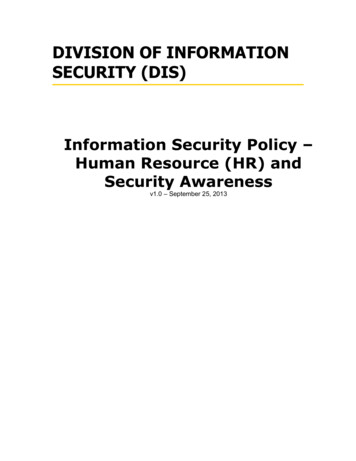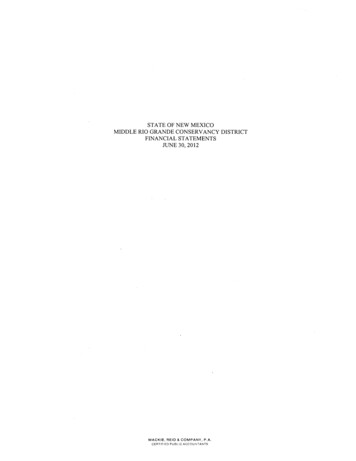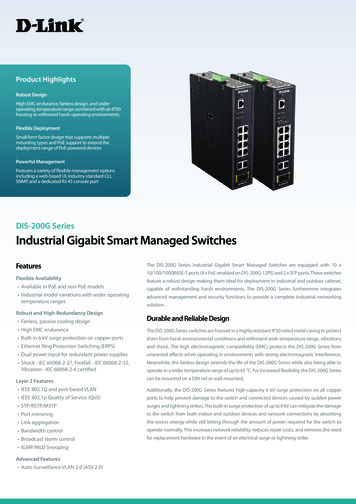
Transcription
DIVISION OF INFORMATIONSECURITY (DIS)Information Security Policy –Human Resource (HR) andSecurity Awarenessv1.0 – September 25, 2013
DIS - Information Security Policy – HR and Security Awarenessv1.0 – 09/25/2013Revision HistoryUpdate this table every time a new edition of the document is publishedDate9/25/20132/10/2014Authored byDivision ofInformation SecurityDivision ofInformation SecurityTitleVer. Notes1.0Initial draft1.0Final version – no changes frominitial draftPage 1
DIS - Information Security Policy – HR and Security Awarenessv1.0 – 09/25/2013Table of ContentsINTRODUCTION . 3PART 1. PREFACE . 3PART 2. ORGANIZATIONAL AND FUNCTIONAL RESPONSIBILITIES . 3PART 3. PURPOSE . 4PART 4. OVERVIEW . 4INFORMATION SECURITY POLICY . 5Human Resource (HR) and Security Awareness . 51.1Human Resource Compliance . 51.2Security Awareness Training . 6DEFINITIONS. 7Page 2
DIS - Information Security Policy – HR and Security Awarenessv1.0 – 09/25/2013INTRODUCTIONPart 1. PrefaceThe South Carolina Information Security (INFOSEC) Program consists of information securitypolicies that establish a common information security framework across South Carolina StateGovernment Agencies and Institutions.Together these policies provide a framework for developing an agency’s information securityprogram. An effective information security program improves the State’s security posture andaligns information security with an agency’s mission, goals, and objectives.Part 2. Organizational and Functional ResponsibilitiesThe policy sets the minimum level of responsibility for the following individuals and/or groups: Division of Information Security Agency/Institution Employees, Contractors, and Third Parties(A) Division of Information SecurityThe duties of the Division of Information Security are: Developing, maintaining, and revising information security policies, procedures, andstandards Providing technical assistance, advice, and recommendations concerning informationsecurity matters(B) Agency/InstitutionInformation security is an agency/institution responsibility shared by all members of the Stateagency/institution management team. The management team shall provide clear direction andvisible support for security initiatives. Each agency/institution is responsible for: Initiating measures to assure and demonstrate compliance with the securityrequirements outlined in this policy Implementing and maintaining an Information Security Program Identifying a role (position/person/title) that is responsible for implementing andmaintaining the agency security program Ensuring that security is part of the information planning and procurement process Participating in annual information systems data security self-audits focusing oncompliance to this State data security policy Determining the feasibility of conducting regular external and internal vulnerabilityassessments and penetration testing to verify security controls are working properly andto identify weaknesses Implementing a risk management process for the life cycle of each critical informationsystem Assuring the confidentiality, integrity, availability, and accountability of all agencyinformation while it is being processed, stored, and/or transmitted electronically, and thesecurity of the resources associated with those processing functions Assuming the lead role in resolving agency security and privacy incidentsPage 3
DIS - Information Security Policy – HR and Security Awareness v1.0 – 09/25/2013Ensuring separation of duties and assigning appropriate system permissions andresponsibilities for agency system usersIdentifying ‘business owners’ for any new system that are responsible for:o Classifying datao Approving access and permissions to the datao Ensuring methods are in place to prevent and monitor inappropriate access toconfidential datao Determining when to retire or purge the data(C) Employees, Contractors and Third PartiesAll State employees, contractors, and third party personnel are responsible for: Being aware of and complying with statewide and internal policies and theirresponsibilities for protecting information assets of their agency and the State Using information resources only for intended purposes as defined by policies, laws andregulations of the State or agency Being accountable for their actions relating to their use of all State information systemsPart 3. PurposeThe information security policies set forth the minimum requirements that are used to govern theSouth Carolina Information Security (INFOSEC) Program. Agencies and institutions areexpected to comply with the State’s information security policies. Agencies and institutions mayleverage existing policies or develop policies based on the guidance from the State’sinformation security policies. These policies exist in addition to all other [Agency] policies andfederal and state regulations governing the protection of [Agency] data. Adherence to thepolicies will improve the security posture of the State and help safeguard [Agency] informationtechnology resources.Part 4. OverviewEach information security policy consists of the following: Purpose: Provides background to each area of the information security policies. Policy: Contains detailed policies that relate to each information security section, andare associated with National Institute of Standards and Technology (NIST) SpecialPublications (SP) 800-53 Revision 4 controls. Policy Supplement: Contains the security solution requirements and recommendationsthat are connected to the South Carolina Information Security Standards. Guidance: Provides references to guidelines on information security policies.Page 4
DIS - Information Security Policy – HR and Security Awarenessv1.0 – 09/25/2013INFORMATION SECURITY POLICYHuman Resource (HR) and Security Awareness1.1Human Resource CompliancePurposeThe purpose of human resource (HR) compliance is to define securityroles and responsibilities for employees, contractors and third partyusers.PolicyPersonnel Security Policy and Procedures (PE 1) [Agency] shall define security roles and responsibilities ofemployees, contractors and third party users and shall bedocumented in accordance with the organization’s informationsecurity policy.Personnel Screening (PS 3) and Third-Party Personnel Security (PS 7) [Agency] shall conduct background verification checks on allcandidates for employment, including contractors, and third partyusers, and shall be carried out in accordance with relevant laws.Personnel Termination (PS 4) and Transfer (PS 5) Upon termination / transfer of employment for employees,termination of engagement for non-employees, or immediately uponrequest, personnel shall return to the [Agency] all agency documents(and all copies thereof) and other agency property and materials intheir possession or control.Access Agreements (PS 6) As part of their information security obligation, employees,contractors and third party users shall agree and sign an acceptableuse policy, which shall state responsibilities for information security.Policy SupplementA policy supplement has not been identified.GuidanceNIST SP 800-53 Revision 4: PE 1 Personnel Security Policy andProceduresNIST SP 800-53 Revision 4: PS 3 Personnel ScreeningNIST SP 800-53 Revision 4: PS 4 Personnel TerminationNIST SP 800-53 Revision 4: PS 5 Personnel TransferNIST SP 800-53 Revision 4: PS 6 Access AgreementsNIST SP 800-53 Revision 4: PS 7 Third-Party Personnel SecurityPage 5
DIS - Information Security Policy – HR and Security Awareness1.2v1.0 – 09/25/2013Security Awareness TrainingPurposeThe purpose of security and awareness training is to define theinformation security training requirements for [Agency] employees,contractors and third party users.PolicySecurity Awareness Training (AT 2) and Information Security Workforce(PM 13) [Agency] management shall require employees, contractors and thirdparty users to apply security in accordance with established policiesand procedures of the organization.Role-Based Security Training (AT 3) [Agency] shall impart appropriate awareness training and regularupdates in organizational policies and procedures to all employees ofthe organization and to, contractors and third party users, as relevantfor their job function.o Training must be accompanied by an assessment procedurebased on the cyber security training content presented inorder to determine comprehension of key cyber securityconcepts and procedures. User access to [Agency] information assets and systems will only beauthorized for those users whose cyber security awareness trainingis current (e.g., having passed the most recent required trainingstage).Testing, Training, and Monitoring (PM 14) [Agency] will appoint a cyber-security awareness training coordinatorto manage training content, schedules and user training completionstatus. The [Agency] cyber security training coordinator, along with theagency CISO or security manager will review training content on anannual basis to ensure that it aligns with State of South Carolinapolicies.Policy SupplementA policy supplement has not been identified.GuidanceNIST SP 800-53 Revision 4: AT 2 Security Awareness TrainingNIST SP 800-53 Revision 4: AT 3 Role-Based Security TrainingNIST SP 800-53 Revision 4: PM 13 Information Security WorkforceNIST SP 800-53 Revision 4: PM 14 Testing, Training, and MonitoringPage 6
DIS - Information Security Policy – HR and Security Awarenessv1.0 – 09/25/2013DEFINITIONSAuthentication: The process of establishing confidence in user identities through a well specified messageexchange process that verifies possession of a password, token to remotely authenticate a claimant.Authorization: Authorization is the process of enforcing policies: determining what types or qualities of activities,resources, or services a user is permitted. Authorization occurs within the context of authentication. Once a user hasbeen authenticated, they may be authorized for different types of access.Brute force attacks: A method of accessing an obstructed device through attempting multiple combinations ofnumeric/alphanumeric passwords.Data at rest: All data in storage, regardless of the storage device, that is not in motion. This excludes informationtraversing a network or temporarily residing in non-volatile computer memory. Data at rest primarily resides in fileson a file system. However, data at rest is not limited to file data. Databases, for example, are often backed by datafiles, and their contents can be thought of as rows and columns of data elements instead of as individual files.Agency should consider all aspects of storage when designing an encryption solution.Degaussing: Degaussing is exposing the magnetic media to a strong magnetic field in order to disrupt the recordedmagnetic domains.Least privilege: Every program and every user of the system should operate using the least set of privilegesnecessary to complete the job. Primarily this principle limits the damage that can result from an accident or error. This principle requires that each subject in a system be granted the most restrictive set of privileges (or lowestclearance) needed for the performance of authorized tasks only for the minimum amount of time necessary. Theapplication of this principle limits the damage that can result from accident, error, or unauthorized use or activity.Media sanitization: Media sanitization is a process by which data is irreversibly removed from media or the mediais permanently destroyed. There are different types of sanitization for each type of media including: disposal,clearing, purging and destroying.Obfuscation: Data masking or data obfuscation is the process of de-identifying (masking) specific data elementswithin data stores. The main reason for applying masking to a data field is to protect data that is classified aspersonal identifiable data, personal sensitive data or commercially sensitive data; however the data must remainusable for the purposes of undertaking valid test cycles.RBAC: A role based access control (RBAC) policy bases access control decisions on the functions a user is allowedto perform within an organization. The users cannot pass access permissions on to other users at their discretion. Arole is essentially a collection of permissions, and all users receive permissions only through the roles to which theyare assigned, or through roles they inherit through the role hierarchy. Within an organization, roles are relativelystable, while users and permissions are both numerous and may change rapidly.SDLC: The multistep process that starts with the initiation, analysis, design, and implementation, and continuesthrough the maintenance and disposal of the system, is called the System Development Life Cycle (SDLC).Two-factor authentication (2FA): Authentication systems identify three factors as the cornerstone ofauthentication: Something you know (for example, a password); something you have (for example, an ID badge or acryptographic key); something you are. Multi-factor authentication refers to the use of two of these three factorslisted above.Page 7
Data masking or data obfuscation is the process of de-identifying (masking) specific data elements within data stores. The main reason for applying masking to a data field is to protect data that is classified as personal identifiable data, personal sensitive data or commercially sensitive data; however the data must remain











